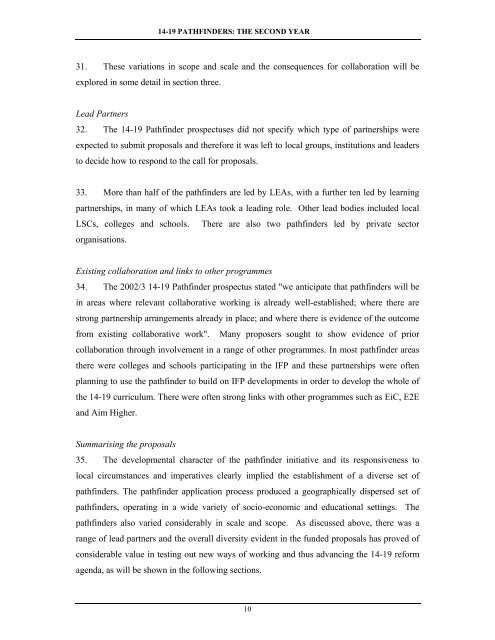Collaborative Approaches to 14-19 Provision - Communities and ...
Collaborative Approaches to 14-19 Provision - Communities and ...
Collaborative Approaches to 14-19 Provision - Communities and ...
- No tags were found...
Create successful ePaper yourself
Turn your PDF publications into a flip-book with our unique Google optimized e-Paper software.
<strong>14</strong>-<strong>19</strong> PATHFINDERS: THE SECOND YEAR31. These variations in scope <strong>and</strong> scale <strong>and</strong> the consequences for collaboration will beexplored in some detail in section three.Lead Partners32. The <strong>14</strong>-<strong>19</strong> Pathfinder prospectuses did not specify which type of partnerships wereexpected <strong>to</strong> submit proposals <strong>and</strong> therefore it was left <strong>to</strong> local groups, institutions <strong>and</strong> leaders<strong>to</strong> decide how <strong>to</strong> respond <strong>to</strong> the call for proposals.33. More than half of the pathfinders are led by LEAs, with a further ten led by learningpartnerships, in many of which LEAs <strong>to</strong>ok a leading role. Other lead bodies included localLSCs, colleges <strong>and</strong> schools. There are also two pathfinders led by private sec<strong>to</strong>rorganisations.Existing collaboration <strong>and</strong> links <strong>to</strong> other programmes34. The 2002/3 <strong>14</strong>-<strong>19</strong> Pathfinder prospectus stated "we anticipate that pathfinders will bein areas where relevant collaborative working is already well-established; where there arestrong partnership arrangements already in place; <strong>and</strong> where there is evidence of the outcomefrom existing collaborative work". Many proposers sought <strong>to</strong> show evidence of priorcollaboration through involvement in a range of other programmes. In most pathfinder areasthere were colleges <strong>and</strong> schools participating in the IFP <strong>and</strong> these partnerships were oftenplanning <strong>to</strong> use the pathfinder <strong>to</strong> build on IFP developments in order <strong>to</strong> develop the whole ofthe <strong>14</strong>-<strong>19</strong> curriculum. There were often strong links with other programmes such as EiC, E2E<strong>and</strong> Aim Higher.Summarising the proposals35. The developmental character of the pathfinder initiative <strong>and</strong> its responsiveness <strong>to</strong>local circumstances <strong>and</strong> imperatives clearly implied the establishment of a diverse set ofpathfinders. The pathfinder application process produced a geographically dispersed set ofpathfinders, operating in a wide variety of socio-economic <strong>and</strong> educational settings. Thepathfinders also varied considerably in scale <strong>and</strong> scope. As discussed above, there was arange of lead partners <strong>and</strong> the overall diversity evident in the funded proposals has proved ofconsiderable value in testing out new ways of working <strong>and</strong> thus advancing the <strong>14</strong>-<strong>19</strong> reformagenda, as will be shown in the following sections.10
















